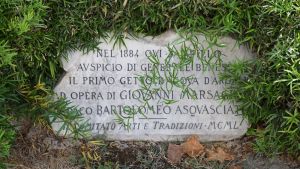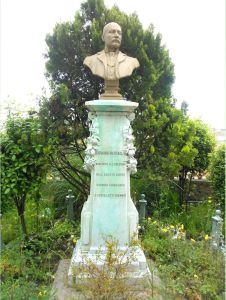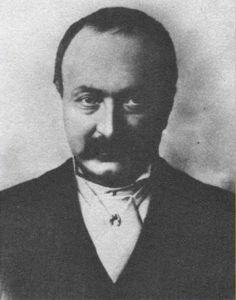Entrepreneur and Engineer
Born in Turin on 23 May 1845, Giovanni Marsaglia is particularly attached to our city because of the important urban changes he made to the city in the second half of the 19th century.
He was the first of three brothers in the noble Marsaglia family, a famous and wealthy lineage of entrepreneurs and builders from Turin, known for his philanthropy and generosity.
It was the construction of the Genoa-Ventimiglia Railway, which began in 1857, that united the fate of the Marsaglia family with Sanremo and opened the way to young Giovanni and his brothers Ernesto and Luigi.
Giovanni's uncle, who was also an engineer, managed the works of this new line, whose construction, commissioned by Camillo Benso Conte di Cavour with a view to the ambitious project of a railway network branching out across the whole peninsula, was considered by the patriots of the union a determining factor in accelerating the unification process of the then Kingdom of Italy.
In 1860 a decree issued by the Kingdom of Italy decided to build the Ligurian Railway, a railway line linking Ventimiglia with Massa Carrara, passing through the railway station of Sanremo, and the mammoth construction works began.
At the sudden death of his uncle, who was directing the works of the last section, the work of completion was entrusted to his nephew Giovanni.
By the age of twenty-one, the young scion had already graduated in engineering: in 1867 he was already assistant to the Technical Commission of the General Exhibition in Paris, and at the time he was practicing in Belgium, working in coal mines and metallurgical plants.
From 1873 onwards, the engineer began to build railways all over Europe, from Sicily to Hungary. In Switzerland he built the southern entrance to the Gotthard tunnel.
The family bank, F.lli Marsaglia, survived the financial turmoil of the 1980s unscathed and in 1894 became the Piedmontese partner of the Banca Commerciale Italiana (Comit), created that year by Otto Joel to bring Central European capital to Italy, and later led by Giuseppe Toeplitz and Raffaele Mattioli.
Having become part of the mainstay of European capitalism, Giovanni Marsaglia continued to work in western Liguria, working at the instigation of Crédit Lyonnaise on the radical transformation of Ospedaletti and building the Sanremo and Porto Maurizio aqueducts.
The family bank had interests and shareholdings in the country's major construction, hydroelectric, mechanical and automobile companies.
Between 1871 and 1873 the works on the railway were completed (on 25th January 1872 the line was completed reaching Ventimiglia).
Giovanni soon adapted to the social life of Sanremo. He frequented the salons of the highest nobility of Matuzzo, including that of Countess Adele Bianchi, wife of Count Stefano Roverizio of Roccasterone, of Cerianasca lineage, who had been Mayor of Sanremo on several occasions.
He immediately fell in love with Giuseppina, the fifth of the Countess' eight daughters, and the two of them got married in 1875. Ernesto and Luigi, Giovanni's brothers, also marrying two of the Countess Adele's daughters (and indeed Luigi, who had remained a widower, married a third), helped to establish the family in Sanremo. A vast piece of land was purchased which ran from Corso Imperatrice, next to the park of the Hotel Royal, to beyond the Corso degli Inglesi. One of his most important works for Sanremo was the completion in 1883 of a large aqueduct that stretched from Argallo for 28 km to Sanremo, a work that contributed significantly to resolving the problem of water supply in this area in the last decade of the 19th century.
One of his most important works for Sanremo was the completion in 1883 of a large aqueduct that stretched from Argallo for 28 km to Sanremo, a work that contributed significantly to resolving the problem of water supply in this area in the last decade of the 19th century.
 Giovanni Marsaglia also worked outside the city and the Ligurian territory: he carried out countless works in the nearby town of Ospedaletti on behalf of Crédit Lyonnais and was responsible for the construction of railway lines in Calabria, Sicily and Sardinia. His work continued even abroad: in Austria, where he was one of the designers of the south tunnel of the Gotthard railway tunnel, and in Hungary, where he was responsible for the construction of the bridge between the two areas of the capital, Buda and Pest. The use of dynamite for the construction of his tunnels and tunnels was also the basis for the establishment of a great friendship with the famous scientist and inventor, Alfred Nobel, who was also a personality linked to the history of the city of Sanremo.
Giovanni Marsaglia also worked outside the city and the Ligurian territory: he carried out countless works in the nearby town of Ospedaletti on behalf of Crédit Lyonnais and was responsible for the construction of railway lines in Calabria, Sicily and Sardinia. His work continued even abroad: in Austria, where he was one of the designers of the south tunnel of the Gotthard railway tunnel, and in Hungary, where he was responsible for the construction of the bridge between the two areas of the capital, Buda and Pest. The use of dynamite for the construction of his tunnels and tunnels was also the basis for the establishment of a great friendship with the famous scientist and inventor, Alfred Nobel, who was also a personality linked to the history of the city of Sanremo.
Giovanni died when he was only 55 years old, in 1900, and his widow Giuseppina wanted to honour him by donating to the Town Hall a large plot of land belonging to her for the enlargement of the cemetery of the mouth, where her husband was resting.
Giovanni Marsaglia's sons, Vincenzo and Roberto, founded in 1913 the STEL, Società Trasporti Elettrici Sanremo Litorale.
(News from INFO Sanremo)





